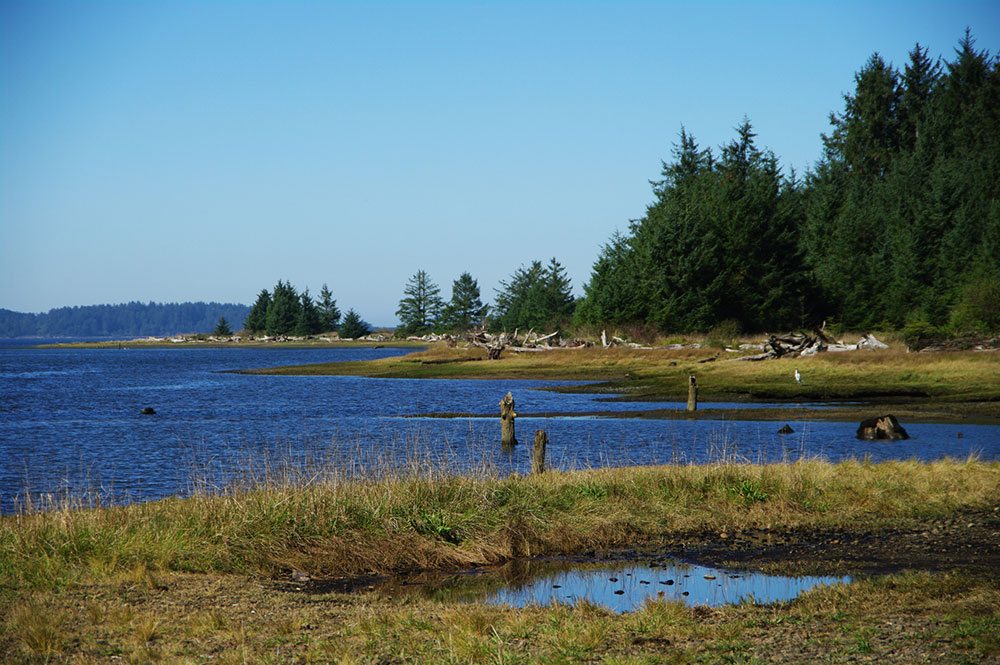Tillamook County has a place for quiet, nature observation. This is Kilchis Point Reserve.
Owned and managed by the Tillamook County Pioneer Museum, the property encompasses about 200 acres of forest, tidal marsh and bay shore, with two miles of well-built trails. The site is very flat, so altitude gain/loss is negligible.
The beginning of the trail is “paved” with cobblestone-like blocks, and the remainder is finished with pea gravel, surprisingly quiet under foot. Reflecting its ownership, numerous interpretive signs are placed along the trails, describing the life of the Tillamook Indians, the early Caucasian settlers, and the local wildlife.
At the entrance, the trail system begins and ends in a former pasture grown up to blackberries and shrubbery. Red Cedars and other trees are planted here and should develop into a more forested condition in a few years.
Most of the trail systems loops through a mixed forest of Red Alder, Cascara, Sitka Spruce, and Western Hemlock, with a well-developed shrubby understory. This is a fairly young forest, and over time it should mature with more and larger conifers, and fewer deciduous trees. In its current stage of succession, it is very diverse and full of life. The longest trail leads to the shore of Tillamook Bay, a short distance west of the confluence of the Kilchis River.
Personal Report
In this report, I will highlight a few of my observations in each habitat from a recent (mid-October) visit. I’ll be visiting again, as this reserve is worth a look in all seasons.
On my last visit, the old-field area provided habitat for numerous sparrows and other seed-eating birds. A juvenile Brush Rabbit crouched at the edge of a blackberry patch, pretending to be invisible.
Brush Rabbits are the local native representatives of the cottontail rabbits, although they have little white on their tails. They live in western Oregon and California, from the Columbia River south. Evidently, at the end of the last ice age, as the local fauna and flora extended its range north, these rabbits found the Columbia an impassible barrier, leaving western Washington with no native cottontails, despite abundant habitat.
I also found several webs of Cross Orbweaver Spiders (Araneus diadematus). These spiders are brown with yellow legs, with an intricate dorsal pattern of bars and arcs diverging from a white central stripe. They are most obvious in fall, when they are largest and build the largest webs. They are “irruptive” in the sense that their local distribution and abundance vary greatly from year to year. In a given year, I tend to find a few locations with numerous webs clustered within an area of a few hundred feet, but then find none at that site for years.
The things that caught my attention in the forest were mushrooms, Douglas Pine Squirrels, and flocks of small insectivorous birds.
Recent rains stimulated the emergence of numerous mushrooms, including clumps of a pale yellow coral mushroom. Others along the trail included large clusters of small yellow caps, and a solitary larger one with a flat top.
The Douglas Pine Squirrels (aka Chickarees) were very vocal in the forest. At times they were complaining about my presence, otherwise they mainly seemed to be scolding each other. This is the season when they cut the cones down from the Sitka Spruce trees and store them for winter food, and they seemed to be fighting over the trees with the best cone crops.
The woods were full of flocks of small songbirds, including chickadees, kinglets, Bushtits, Brown Creepers, Pacific Wrens, and others. These birds will winter here, traveling in flocks of up to 30 birds, gleaning the trunks and branches for spider egg sacs and hibernating insects. They go over and over the forest all winter, and still find enough food to make it through. Imagine the number of spiders and insects there would be in spring if this harvesting had not happened! The birds keep track of each other with high-pitched contact calls, allowing them to travel together, and making them more secure from predators. The calls also helped me to find the flocks, and judge their direction of movement.
A small flock of waterfowl was present on the bay shore, including Canada Geese, Mallards, American Wigeons, and Northern Pintails. Several gulls and a Great Blue heron were also present, and a Great Egret joined them.
Visitors can find Kilchis Point Preserve at the south end of Bay City. Turn southwest off US 101 at milepost 60.7 onto Warren Street, cross the railroad tracks and go one long block. The entrance and parking area is on the left. Traveling southbound, the turn is marked by a sign.
Possible bird sightings include:
| One the Bay: | In the Woods: |
|---|---|
| Canada Goose | Red-shouldered Hawk |
| Cackling Goose | Northern Flicker |
| Northern Pintail | Red-breasted Sapsucker |
| American Wigeon | Steller’s Jay |
| Mallard | Common Raven |
| Great Blue Heron | Black-capped Chickadee |
| Great Egret | Chestnut-backed Chickadee |
| Western Gull | Bushtit |
| Glaucous-winged Gull | Brown Creeper |
| California Gull | Pacific Wren |
| Mew Gull | Cedar Waxwing |
| American Robin | |
| Ruby-crowned Kinglet | |
| Golden-crowned Kinglet | |
| Song Sparrow | |
| Fox Sparrow | |
| White-crowned Sparrow | |
| Golden-crowned Sparrow | |
| Spotted Towhee |
